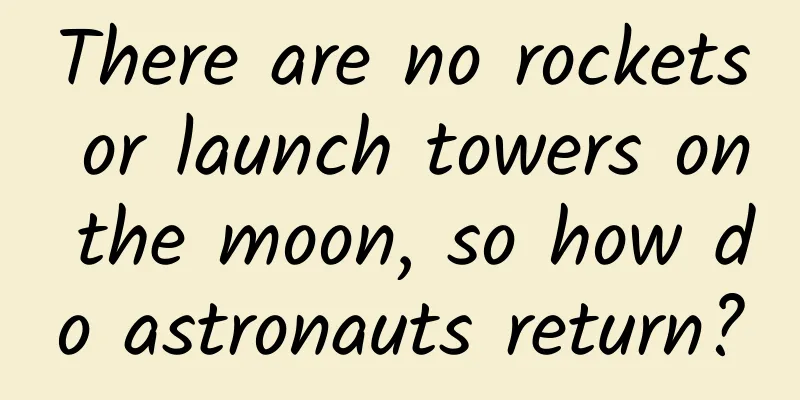There are no rockets or launch towers on the moon, so how do astronauts return?

|
It has been decades since the first successful manned moon landing, but this "big step" for mankind still makes countless people excited. However, some people still wonder how the Americans returned to the moon when there were no rockets or launch towers. Scientists say: They just hitchhiked. How can I get a ride? Before understanding this issue, we must first know that the conditions for leaving the Earth and leaving the Moon are different. The spacecraft carried by the rocket must reach the second cosmic speed, which is 11.2 kilometers per second, in order to escape from the Earth's orbit. The Moon's size and mass are smaller than the Earth's, resulting in an escape velocity of only 2.4 kilometers per second. Therefore, if you want to return from the moon, you don’t need a huge amount of power, you just need to take a ride. This "hitchhiking" refers to a part of the spacecraft. The rocket carrying the Apollo spacecraft is divided into four parts: from top to bottom, they are the command module, service module, ascent stage and descent stage. The ascent stage and descent stage are collectively called the lunar module. The command module is mainly a place where astronauts receive ground information and is also their living space. The service module carries fuel, giving the spacecraft enough power to return to Earth. The ascent stage is where astronauts temporarily live when they are performing the lunar landing mission. The descending section is the "ride". Moon mission After Apollo 11 arrived on the moon, the lunar module quickly separated from Apollo and landed on the lunar surface. At that time, there were only two astronauts entering the lunar module, Armstrong and Aldrin, while Collins stayed in the command module ready to respond at any time. After the lunar module arrived on the ground, the descent stage slowly spread out its "limbs" like a tray, lifting the ascending stage. On the one hand, it was to allow the lunar module to be firmly docked on the lunar surface, making it easier for Armstrong to carry out his lunar landing mission. On the other hand, it can also serve as a simple launching tower for the ascending stage. As the world watched, Armstrong successfully completed his mission and returned to the cabin. At this time, they need to activate the ascent stage, separate from the descent stage, and use the limited fuel to enter the lunar orbit. It sounds simple, but the actual operation really tests the astronauts' control of timing. Because, during the launch process, it is necessary to follow the direction of the moon's rotation and choose a correct angle so that the ascent stage can escape. This is to utilize the eccentricity of the moon's rotation, so that the ascent stage will not be affected by the reverse force caused by the moon's rotation when entering the moon's orbit. If the astronauts chose the wrong timing or made a mistake in the angle, they would most likely be stranded on the moon due to lack of fuel. The two Apollo astronauts relied on their cool heads to reach the moon's orbit in one fell swoop. At this time, Collins in the command module had been waiting for a long time. They only needed to accurately dock the ascent stage and the service module, and then they could drive the spacecraft back to Earth. The whole process went smoothly, and the two astronauts who landed on the moon successfully returned to the command module. Afterwards, in order to reduce the weight of the spacecraft and reduce fuel consumption, the ascent stage will be discarded in space. After entering the Earth's orbit, the service module will be discarded in space, and only the command module will actually return to Earth. In fact, there are two most difficult aspects of the manned lunar landing process. The first is how to return to the Earth's orbit after landing on the moon, and the second is how to ensure the safe return of astronauts after entering the Earth's orbit. Return to Earth The process of a spacecraft entering the earth from orbit is an accelerated process, during which high temperature and huge impact will be generated on the surface of the spacecraft, with the fastest speed reaching 11.2 kilometers per second. If a spacecraft were to head straight for the ground at this speed, with current human technology, the end result would be a blazing fire followed by the destruction of the craft and the death of all on board. If the spacecraft wants to avoid this situation, its initial speed when entering the atmosphere must be 0. Considering the distance between the ground and the atmosphere, the acceleration process can ensure that the astronauts in the cabin are still alive after the spacecraft falls. However, if astronauts want to enter the Earth's orbit, their speed cannot be too low. In this case, if Apollo directly rushed into the Earth's atmosphere, the initial speed would be a terrifying number. At that time, NASA tried to make Apollo 11 make a braking curve in Earth orbit, reducing the initial speed to the "freezing point" before entering the atmosphere. But who knew that Apollo 11 did not control its flight speed well, and after entering the Earth's orbit it could not stop at all, and rushed straight into the atmosphere. At this rate, there was no way the three astronauts of Apollo 11 would reach the ground alive. NASA had no way to deal with this and could only pray for a miracle to happen. A miracle really happened. Because Apollo 11 entered the Earth's atmosphere at a very special angle, it jumped out of the atmosphere under the influence of the Earth's gravity and eccentricity. At this time, Apollo 11's initial speed dropped to 0. Later, NASA called this control technology "secondary entry", and we called it "skipping stones". The principle is very simple. Before entering the atmosphere, the spacecraft is thrown out of the atmosphere through the acceleration of the spacecraft and the various forces of the earth, thereby resetting the initial speed of the spacecraft. However, it is extremely difficult to implement in practice. With science and technology so advanced today, there are only a handful of countries that have truly mastered the "skipping stones" technique. During its return to Earth, my country's Chang'e-5 successfully completed the feat of "skipping stones" in the atmosphere, leaving many developed countries far behind. Apollo 11 completed the "extreme operation" with the help of luck, which can be said to be a combination of the right time, the right place and the right people. Moon landing hoax? However, there have been claims that the Apollo 11 moon landing was actually a hoax because there is no launch pad on the moon and Apollo could not return to Earth. Some people also said that the United States did not plan any new moon landing plan in the decades after completing the manned moon landing. If Apollo 11 really landed on the moon, the United States should have landed on the moon frequently. Why did it remain silent for decades? There are two reasons: On the one hand, the value of landing on the moon has not been that high since the feat of landing a man on the moon. Coupled with the continuous advancement of the United States' exploration of the lunar surface, humanity has fallen into a bottleneck period. As a result, the focus of the U.S. space program shifted to Mars. On the other hand, the cost of manned lunar landing is very high, and the US finances are no longer able to support subsequent lunar landing plans. At that time, the Apollo program seriously squeezed the fiscal budget, resulting in slow development in the economy, military and other aspects. At the same time, the US fiscal revenue gradually declined. The government had to reduce the fiscal budget for people's livelihood to make up for the deficit in other areas, which caused great dissatisfaction among the people. Between 1961 and 1970, the United States spent $25 billion (equivalent to $150 billion in 2018). The Apollo program did bring honor to Americans, but in the long run it would inevitably drag down the domestic economy. The US government halted the program in 1972 and turned to developing a space station. Therefore, it is an indisputable fact that the United States successfully landed on the moon, but it is undeniable that the "hitchhiking" back to Earth did involve an element of luck, and NASA does not dare to attempt another manned lunar landing in a short period of time. With the rise of countries around the world, the aerospace field is no longer dominated by the United States and the Soviet Union. my country's aerospace sector is developing in full swing. I believe that in the near future, my country will lead the world's aerospace technology to a new height. What do you think about this? Welcome to leave a message in the comment area. Follow CHN Jiuxiang Technology, and through popular science, you will find that there are too many wonderful things in this world. |
<<: [Smart Farmers] Why the beautiful Canada goldenrod became the "devil's flower"
>>: Does liver cancer come quietly? Why is early liver cancer painless? Read more →
Recommend
I have learned the 8 major factors that affect SEM traffic. If there is no effect, I lose!
Introduction: The most basic factor that determin...
What can be done when evolution meets algorithms?
Everyone knows about the evolution of plants and ...
Xingping SEO Training: What is spider pool? What is the use of Baidu Spider Pool?
What is Spider Pool? Spider Pool is a hacker prog...
Nintendo's new Switch, the OLED screen is still 720P, users suspect it comes from Audi's inventory
Nintendo Switch has been on the market for more t...
When will the Shanghai epidemic end in 2022? What is the latest list of gated communities? Details attached!
The recent local epidemic in Shanghai has become t...
Is your child's myopia increasing rapidly? Maybe you didn't choose the right glasses! Parents must read these 3 points!
Before the age of thirteen, it is an important st...
Pretentious, emotionally unstable? No! Stop scolding! We are just sensitive to order...
We all live with social evaluations and are influ...
Renewable energy and zero waste future: wind power and photovoltaic recycling industry development research report
Greenpeace, an international environmental organi...
Momo information flow advertising skills, play with pan-entertainment social information flow advertising!
Written in front Momo is a pan-entertainment soci...
Service is an important component in Android development
Service Component 「Service」 is a component in And...
Why do batteries become as “afraid of the cold” as you are in winter?
Produced by: Science Popularization China Author:...
618 headline traffic forecast and advertising suggestions!
618 headline traffic estimation & delivery su...
Lily SEO Training: What are the benefits of SEO website structure optimization?
SEO optimization includes many aspects, such as k...
What are numbers? How do our brains perceive numbers?
A philosophical question has gradually evolved in...
A ranking of 6 common iron-rich foods. I never thought that the "king" would be this one!
When it comes to "iron and blood supplements...









